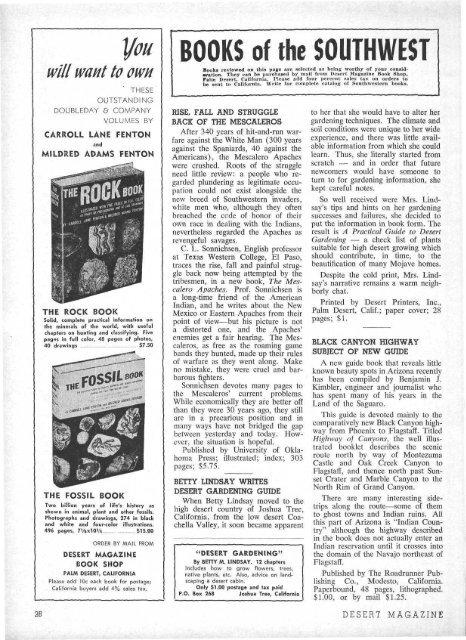Desert Book - Desert Magazine of the Southwest
Desert Book - Desert Magazine of the Southwest
Desert Book - Desert Magazine of the Southwest
Create successful ePaper yourself
Turn your PDF publications into a flip-book with our unique Google optimized e-Paper software.
you<br />
will want to own<br />
THESE<br />
OUTSTANDING<br />
DOUBLEDAY & COMPANY<br />
VOLUMES BY<br />
CARROLL LANE FENTON<br />
and<br />
MILDRED ADAMS FENTON<br />
THE ROCK BOOK<br />
Solid, complete practical information on<br />
<strong>the</strong> minerals <strong>of</strong> <strong>the</strong> world, with useful<br />
chapters on hunting and classifying. Five<br />
pages in full color, 48 pages <strong>of</strong> photos,<br />
40 drawings $7.50<br />
THE FOSSIL BOOK<br />
Two billion years <strong>of</strong> life's history as<br />
shown in animal, plant and o<strong>the</strong>r fossils.<br />
Photographs and drawings, 274 in black<br />
and white and four-color illustrations.<br />
496 pages, 7Vfexl0V4 $15.00<br />
ORDER BY MAIL FROM<br />
DESERT MAGAZINE<br />
BOOK SHOP<br />
PALM DESERT, CALIFORNIA<br />
Please add 10c each book for postage;<br />
California buyers add 4% sales tax.<br />
BOOKS <strong>of</strong> <strong>the</strong> SOUTHWEST<br />
<strong>Book</strong>s reviewed on this page are selected as being worthy <strong>of</strong> your consideration.<br />
They can be purchased by mail from <strong>Desert</strong> <strong>Magazine</strong> <strong>Book</strong> Shop,<br />
T*lm <strong>Desert</strong>, California. l'leaae add four percent sales tax on orders to<br />
be sent to California. Write for complete catalog <strong>of</strong> <strong>Southwest</strong>ern books.<br />
RISE, FALL AND STRUGGLE<br />
BACK OF THE MESCALEROS<br />
After 340 years <strong>of</strong> hit-and-run warfare<br />
against <strong>the</strong> White Man (300 years<br />
against <strong>the</strong> Spaniards, 40 against <strong>the</strong><br />
Americans), <strong>the</strong> Mescalero Apaches<br />
were crushed. Roots <strong>of</strong> <strong>the</strong> struggle<br />
need little review: a people who regarded<br />
plundering as legitimate occupation<br />
could not exist alongside <strong>the</strong><br />
new breed <strong>of</strong> <strong>Southwest</strong>ern invaders,<br />
white men who, although <strong>the</strong>y <strong>of</strong>ten<br />
breached <strong>the</strong> cede <strong>of</strong> honor <strong>of</strong> <strong>the</strong>ir<br />
own race in dealing with <strong>the</strong> Indians,<br />
never<strong>the</strong>less regarded <strong>the</strong> Apaches as<br />
revengeful savages.<br />
C. L. Sonnichsen, English pr<strong>of</strong>essor<br />
at Texas Western College, El Paso,<br />
traces <strong>the</strong> rise, fall and painful struggle<br />
back now being attempted by <strong>the</strong><br />
tribesmen, in a new book, The Mescalero<br />
Apaches. Pr<strong>of</strong>. Sonnichsen is<br />
a long-time friend <strong>of</strong> <strong>the</strong> American<br />
Indian, and he writes about <strong>the</strong> New<br />
Mexico or Eastern Apaches from <strong>the</strong>ir<br />
point <strong>of</strong> view—but his picture is not<br />
a distorted one, and <strong>the</strong> Apaches'<br />
enemies get a fair hearing. The Mescaleros,<br />
as free as <strong>the</strong> roaming game<br />
bands <strong>the</strong>y hunted, made up <strong>the</strong>ir rules<br />
<strong>of</strong> warfare as <strong>the</strong>y went along. Make<br />
no mistake, <strong>the</strong>y were cruel and barbarous<br />
fighters.<br />
Sonnichsen devotes many pages to<br />
<strong>the</strong> Mescaleros' current problems.<br />
While economically <strong>the</strong>y are better <strong>of</strong>f<br />
than <strong>the</strong>y were 30 years ago, <strong>the</strong>y still<br />
are in a precarious position and in<br />
many ways have not bridged <strong>the</strong> gap<br />
between yesterday and today. However,<br />
<strong>the</strong> situation is hopeful.<br />
Published by University <strong>of</strong> Oklahoma<br />
Press; illustrated; index; 303<br />
pages; $5.75.<br />
BETTY LINDSAY WRITES<br />
DESERT GARDENING GUIDE<br />
When Betty Lindsay moved to <strong>the</strong><br />
high desert country <strong>of</strong> Joshua Tree,<br />
California, from <strong>the</strong> low desert Coachella<br />
Valley, it soon became apparent<br />
"DESERT GARDENING"<br />
By BETTY M. LINDSAY. 12 chapters<br />
Includes how to grow flowers, trees,<br />
native plants, etc. Also, advice on landscaping<br />
a desert cabin.<br />
Only $1.00 postage and tax paid<br />
P.O. Box 268 Joshua Tree, California<br />
to her that she would have to alter her<br />
gardening techniques. The climate and<br />
soil conditions were unique to her wide<br />
experience, and <strong>the</strong>re was little available<br />
information from which she could<br />
learn. Thus, she literally started from<br />
scratch — and in order that future<br />
newcomers would have someone to<br />
turn to for gardening information, she<br />
kept careful notes.<br />
So well received were Mrs. Lindsay's<br />
tips and hints on her gardening<br />
successes and failures, she decided to<br />
put <strong>the</strong> information in book form. The<br />
result is A Practical Guide to <strong>Desert</strong><br />
Gardening — a check list <strong>of</strong> plants<br />
suitable for high desert growing which<br />
should contribute, in time, to <strong>the</strong><br />
beautification <strong>of</strong> many Mojave homes.<br />
Despite <strong>the</strong> cold print, Mrs. Lindsay's<br />
narrative remains a warm neighborly<br />
chat.<br />
Printed by <strong>Desert</strong> Printers, Inc.,<br />
Palm <strong>Desert</strong>, Calif.; paper cover; 28<br />
pages; $1.<br />
BLACK CANYON HIGHWAY<br />
SUBJECT OF NEW GUIDE<br />
A new guide book that reveals little<br />
known beauty spots in Arizona recently<br />
has been compiled by Benjamin J.<br />
Kimbler, engineer and journalist who<br />
has spent many <strong>of</strong> his years in <strong>the</strong><br />
Land <strong>of</strong> <strong>the</strong> Saguaro.<br />
This guide is devoted mainly to <strong>the</strong><br />
comparatively new Black Canyon highway<br />
from Phoenix to Flagstaff. Titled<br />
Highway <strong>of</strong> Canyons, <strong>the</strong> well illustrated<br />
booklet describes <strong>the</strong> scenic<br />
route north by way <strong>of</strong> Montezuma<br />
Castle and Oak Creek Canyon to<br />
Flagstaff, and <strong>the</strong>nce north past Sunset<br />
Crater and Marble Canyon to <strong>the</strong><br />
North Rim <strong>of</strong> Grand Canyon.<br />
There are many interesting sidetrips<br />
along <strong>the</strong> route—some <strong>of</strong> <strong>the</strong>m<br />
to ghost towns and Indian ruins. All<br />
this part <strong>of</strong> Arizona is "Indian Country"<br />
although <strong>the</strong> highway described<br />
in <strong>the</strong> book does not actually enter an<br />
Indian reservation until it crosses into<br />
<strong>the</strong> domain <strong>of</strong> <strong>the</strong> Navajo nor<strong>the</strong>ast <strong>of</strong><br />
Flagstaff.<br />
Published by The Roadrunner Publishing<br />
Co., Modesto, California.<br />
Paperbound, 48 pages, lithographed.<br />
$1.00, or by mail $1.25.<br />
DESERT MAGAZINE

















